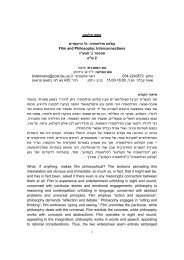The Iconography of the Temple in Northern Renaissance Art
The Iconography of the Temple in Northern Renaissance Art
The Iconography of the Temple in Northern Renaissance Art
You also want an ePaper? Increase the reach of your titles
YUMPU automatically turns print PDFs into web optimized ePapers that Google loves.
e<strong>in</strong>g dom<strong>in</strong>ated by <strong>the</strong> <strong>Temple</strong> which has exactly <strong>the</strong> same form as <strong>in</strong> Synagoga's<br />
crown (see idem, pls. 71-72).<br />
16. In a 12th century ivory, <strong>the</strong> so-called Ivory <strong>of</strong> Bamberg, Synagoga is represented as<br />
an enthroned Queen, wear<strong>in</strong>g a crown composed <strong>of</strong> towers (Jerusalem). She is<br />
seated before <strong>the</strong> <strong>Temple</strong>. (Ch. Cahier and A. Mart<strong>in</strong>, "C<strong>in</strong>q ivoires sculptes",<br />
Mélanges d'Archeologie et de Litterature, Paris, 1851, 2, 56.<br />
17. Lewis, 1986, 546-548, pl. 3.<br />
18. <strong>The</strong> Templum Solomonis is quite <strong>of</strong>ten associated <strong>in</strong> fifteenth century imagery with<br />
<strong>the</strong> Saracen crescent. This association seems to figure for <strong>the</strong> first time <strong>in</strong> <strong>the</strong> 9th<br />
century Journey Book <strong>of</strong> Bernard de Wise, a French monk who describes <strong>the</strong> temple<br />
as an Islamic mosque ('templum Salomonis, s<strong>in</strong>agogum sarracenorum'; cf. Kr<strong>in</strong>sky,<br />
1970, 4 and n. 15).<br />
19. Joseph is identified with <strong>the</strong> <strong>Temple</strong> <strong>of</strong> Jerusalem as Synagoga <strong>in</strong> a 13th century<br />
French Bible Moralisée, London, B.L. Harley Ms. 1527, fol. 5 r .<br />
20. In <strong>the</strong> Testimonia <strong>of</strong> Sa<strong>in</strong>t Cyprian (ca. 210-258), Christ is compared to <strong>the</strong> New<br />
<strong>Temple</strong>. Paul<strong>in</strong>e <strong>the</strong>ology makes an analogy between <strong>the</strong> <strong>Temple</strong> and Christ's Body<br />
(Eph. IV:12, 16; Col. II:19). Cerfaux 1948, 3 and 260-261 emphasises <strong>the</strong> idea that<br />
<strong>the</strong> Church itself is Christ's Body, which replaces <strong>the</strong> Old <strong>Temple</strong>. <strong>The</strong> Church is<br />
<strong>the</strong> New and Spiritual <strong>Temple</strong>.<br />
21. Congar, 1958, 182-183, 311, 334; Christ purified <strong>the</strong> <strong>Temple</strong> three times, <strong>in</strong> his<br />
Presentation, <strong>in</strong> his Passion and Death, and by his Resurrection, when <strong>the</strong> destroyed<br />
<strong>Temple</strong> was rebuilt ibid, 169-70, 172.<br />
22. In Roger Van der Weyden's Presentation (Columba Altarpiece, Munich, Alte<br />
P<strong>in</strong>ako<strong>the</strong>k) a different attitude is manifested. Here <strong>the</strong> Presentation takes place <strong>in</strong><br />
a semi-central Romanesque construction. Accord<strong>in</strong>g to Pan<strong>of</strong>sky 1970, 1, 135, this<br />
signifies a "Jewish ritual performed <strong>in</strong> <strong>the</strong> Jewish <strong>Temple</strong>".<br />
23. Pan<strong>of</strong>sky, 1970, 1, 135.<br />
24. ibid., 136.<br />
25. C. Harbison "Realism and Symbol <strong>in</strong> Early Flemish Pa<strong>in</strong>t<strong>in</strong>g", <strong>Art</strong> Bullet<strong>in</strong>, 66, 1984,<br />
594-95, believes that <strong>the</strong> new Gothic ca<strong>the</strong>dral which is about to be built will replace<br />
<strong>the</strong> old construction. He mentions <strong>the</strong> contemporary custom <strong>of</strong> destroy<strong>in</strong>g older<br />
structures <strong>in</strong> order to make room for new ones.<br />
26. Smith, 1972.<br />
27. Pan<strong>of</strong>sky, 1970, 1, 136, n. 4; Although G. Smith 1972, 116, agrees with Pan<strong>of</strong>sky<br />
that <strong>the</strong> dist<strong>in</strong>ction between <strong>the</strong> structures expresses <strong>the</strong> opposition between<br />
Christianity and Judaism, he believes that <strong>the</strong> Master <strong>of</strong> Flemalle had ano<strong>the</strong>r<br />
metaphor <strong>in</strong> m<strong>in</strong>d <strong>in</strong> jo<strong>in</strong><strong>in</strong>g <strong>the</strong> two build<strong>in</strong>gs. Smith considers that <strong>the</strong> image<br />
expresses <strong>the</strong> idea <strong>of</strong> Christianity grow<strong>in</strong>g out <strong>of</strong> <strong>the</strong> Old Law without destroy<strong>in</strong>g<br />
it, and attempts to establish this view by show<strong>in</strong>g how <strong>the</strong> decoration <strong>of</strong> <strong>the</strong> sta<strong>in</strong>ed<br />
glass w<strong>in</strong>dows and capitals <strong>in</strong> <strong>the</strong> rotunda fits <strong>in</strong>to this iconographical program.<br />
However, it seems that Smith was constra<strong>in</strong>ed by his <strong>the</strong>ory that <strong>the</strong> scenes <strong>of</strong> <strong>the</strong><br />
rotunda decoration are related to <strong>the</strong> Bible Moralisée.<br />
28. <strong>The</strong> punishment <strong>of</strong> Ca<strong>in</strong> was compared to <strong>the</strong> punishment <strong>of</strong> <strong>the</strong> Jews, expelled<br />
and cursed by God. In <strong>the</strong> 15th century Bible Moralisée <strong>in</strong> <strong>the</strong> Heures de Rohan (Paris,<br />
168
















